SECVRITAS (Securitas): The real meaning
(The information about Latin on this page is from Prof. Ted Buttrey, to whom I give credit and thanks.)
What's new? 2022, April 25: Gordian III denarius.
Latin "securitas" is
1) "se-", a particle indicting separation
(as in se-duce, to lead [duco] away (from the right path) se-gregate, to set aside from the mass (grex: flock, crowd) and se-parate itself)
and
2) "cura", care.
(Care can be positive--to take care of someone-- or worrisome, to be careworn.)
To not have any cares is to be "se-cure", without cares.
So on early Roman coins "SECVRITAS" does not mean security in the modern sense (covered with locks and chains and overseen by guns, which may be a means of achieving security) but "the public does not have a care in the world (thanks to me)".
The lady Securitas appears on coins of several early emperors and can be distinguished from all the other Roman imperial figures by having a languid air (since she has no problems) and by sitting back on a throne with elbow resting on the back, or sometimes resting her head on her arm, or if standing, her arm on a column.
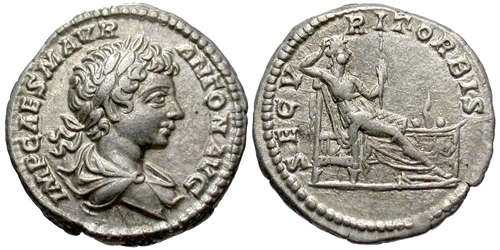
A denarius of Caracalla, Roman emperor (198-217), originally under his father (Septimius Severus, 193-211 AD).
SECVRIT ORBIS (security of the world)
A languid, care-free, Securitas seated leaning back, right. She holds a vertical scepter and behind and to the right there is a lighted and garlanded altar.
Silver. 18 mm. 3.61 grams.
Struck 198-199 at Rome.
BMC V (SS and Caracalla) 118.
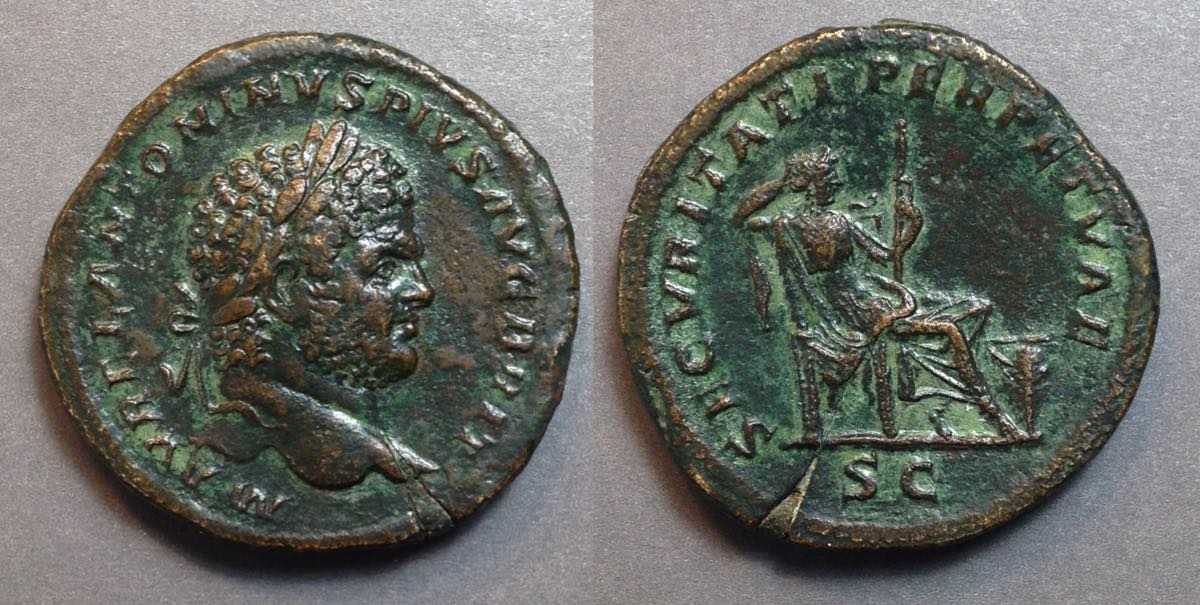
Caracalla, 198-217
32 mm. 24.00 grams.
SECVRITATI PERPETVAE
Securitas seated right, languid air, head supported by right hand resting on back of chair, holding scepter
Sear II 6952. RIC 512d. "213"
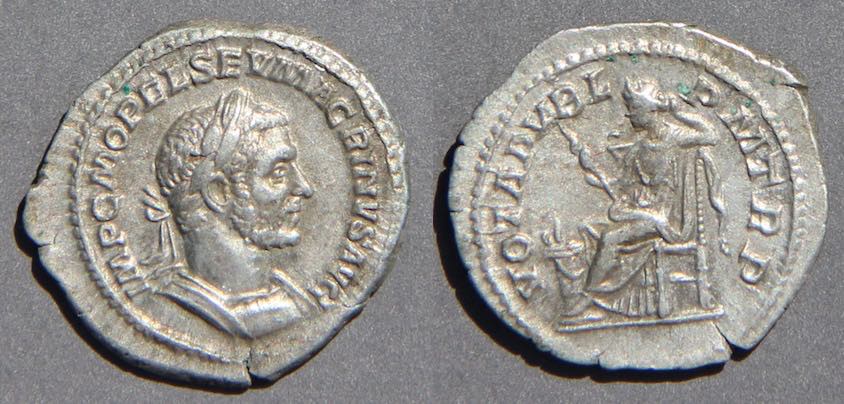 Macrinus, April 11, 217- June 8, 218
Macrinus, April 11, 217- June 8, 218
Denarius. 21-19 mm.
IMP C M OPEL SEV MACRINVS AVG
VOTA PVBL PM TRP
Securitas seated left holding scepter and supporting her head with left hand. Before her, a lighted altar.
Struck April 11-December 217 at Rome.
"Vota Publica" does not mention ten years.
RIC 13.
These were vows taken at the beginning of his reign for the security of the state and the emperor. The explicit date is "TRP" for his first year.
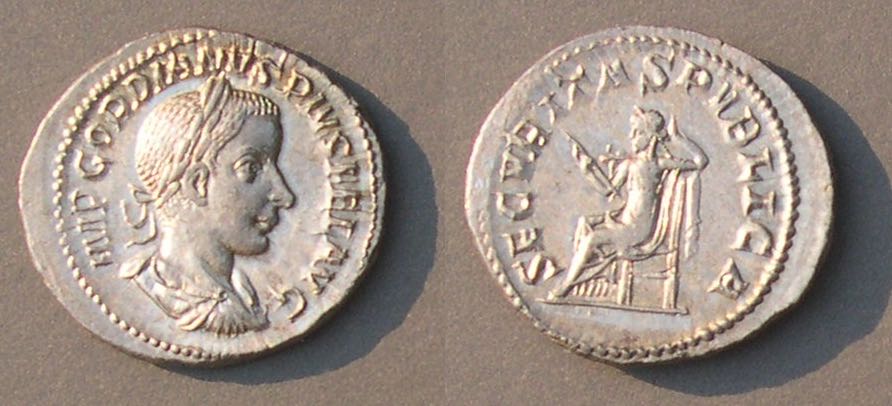 Gordian III, 238-244
Gordian III, 238-244
Denarius. 21-19 mm. 3.66 grams.
IMP GORDIANVS PIVS FEL AVG
SECVRITAS PVBLICA
Securtias seated left holding scepter and supporting her head with left hand.
RIC 130 "R" "special marriage issue, 241"
According to Gnecchi (p. 60), "Securitas almost equals Pax." SECVRITAS types were first issued under Nero as SECVRITAS AVGVSTI and refer to the security the emperor provides, the Roman people (SECVRITAS P ROMANI), or the whole world (SECVRIT ORBIS, as above). The types are various, but through the end of the third century most designs are similar to the one above or the next one.
 Constantius I, 293-305-306
Constantius I, 293-305-306
Struck as Caesar, c. 295
25-21 mm.
An aurelianus, sometimes called an antoninianus.
SECVRITAS AVG, B in exergue.
Securitas standing front, head left, with legs casually crossed, right hand up to the top of her head, and left elbow leaning on column.
There is no tension in this pose.
RIC V.II 644, mint of Lugdunum, page 298.
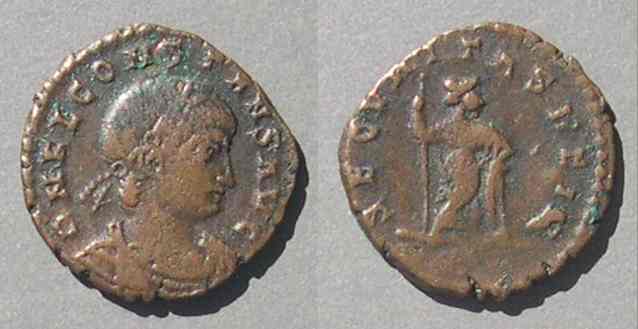 Constans, one son of Constantine. Augustus, 337-350.
Constans, one son of Constantine. Augustus, 337-350.
15 mm. Struck 337 - before April 340 at Rome. On this example the mintmark with "R<palm branch>S" is too weak to read.
SECVRITAS REIP (Security of the Republic = state), Security standing front, head right, holding a long vertical scepter in right and leaning casually on a column.
RIC Rome 34. This type was struck only at the Rome mint. It is listed as "rare" in RIC, but it is really fairly common. However, it is actually rare in full-flan, well-struck, high-grade condition.
The transition from "care-free" to "secure".
The type of Constans above, struck after the death of Constantine, maintains the "care-free" representation. Gnecchi notes, "In the time of Constantine Securitas was again confounded with Pax, but always after a victory, and we then find the emperor in the act of erecting or crowning a trophy." Unfortunately for collectors, the varieties under Constantine are on very rare and very expensive gold coins and medallions.
The first coin on this page is a denarius of Caracalla which illustrates security in its care free aspect. However, even then security was also associated with military success.
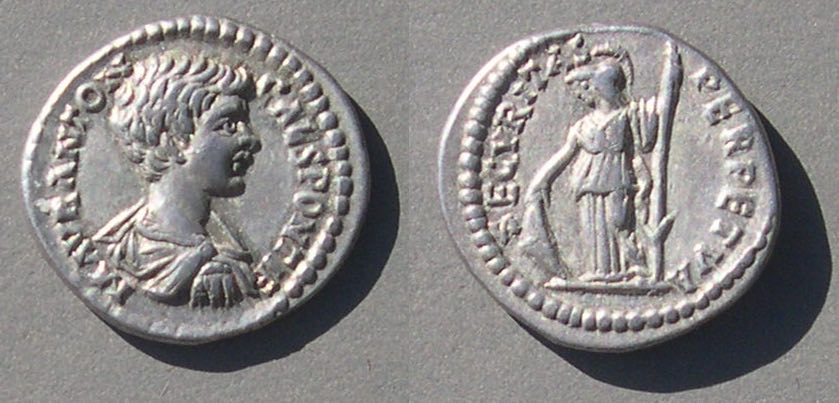 Caracalla, struck 196-197 as Caesar under Septimius Severus at Laodicea ad Mare.
Caracalla, struck 196-197 as Caesar under Septimius Severus at Laodicea ad Mare.
Denarius. 20 mm.
SECVRITAS PERPETVA
Minerva standing left resting right hand on shield and holding reversed spear in left.
After victory there is no need to have spears upright and ready to go.
The "perpetual security" follows military success which brings peace and security. The victory at the time was that of Septimius Severus over Pescennius Niger in the East where this coin was minted.
Sear II 6678 variety. BMC 460.
Under Julian II, the "Apostate" or "Philosopher," an enigmatic use occurs:
 Julian II, Augustus 360-363.
Julian II, Augustus 360-363.
28 mm. 8.57 grams.
SECVRITAS REIPVB•
Bull standing right, two stars above
•CONSPΔ<palm>
This type was struck at all mints. This example is RIC Constantinople "November 3, 361 to June 26, 363."
By this time much of the empire was Christian and Julian's attempt to lead the empire back to the old gods was futile. In Antioch, he and this type were ridiculed. How the "bull" type was intended and interpreted has been the subject of many articles, without consensus, and I will not advocate a solution here. Is it an assertion that the old god's, including Jupiter, to whom sacrifices of bull's were appropriate, would provide the security the republic desired? Is it the "Apis bull" of Egyptian religion? The Mithraic bull?
Jovian, the immediate successor of Julian, used SECVRITAS types on gold but not on copper. However, it became extremely common on copper under the next emperor, Valentinian I, and his co-ruler Valens. It seems the interpretation of Securitas on Roman coins changed toward the modern interpretation.
 Valens, Roman emperor 364-378.
Valens, Roman emperor 364-378.
SECVRITAS REIPVBLICAE (Security of the Republic = state), around winged Victory advancing left and holding wreath and palm (symbols of victory).
Copper. 20-19 mm. 4.70 grams.
RIC IX Rome 17b, struck 364-375.
Mintmark: R PRIMA (Rome, first officina = first mint workshop).
This type is one of the most common Roman types of all. Examples from the Siscia mint are readily available and inexpensive in nice grade. Siscia examples have a mintmark including "SIS".
At this time, more than a century and a half after the first Caracalla piece above, Security has changed from a general reference to care-free life to recognition that care-free life depends upon victories of the military. Ironically, the army of Valens was destroyed and Valens himself was killed by the Visigoths at the famous "Battle of Adrianople" in 378. SECVRITAS REIPVBLICAE was no more.
References:
Roman Imperial Coinage, various volumes.
Gnecchi, F. The Coins Types of Imperial Rome, 1908. 75 pages with no photos or line drawings (only page 60 is on SECVRITAS), reprinted by Ares Publishers in a small hardback which also includes 16 pages of tables on which emperors and family members had portrait types in which denominations, by George Elmer.
Kent, J. P. C. "An Introduction to the Coinage of Julian the Apostate (AD 360-3)," Numismatic Chronicle 1959, pages 109-117 and plates X-XI.
Melville-Jones, John. A Dictionary of Ancient Roman Coins. (1990). Hardback. 329 pages. Seaby Publications.
Vanderspoel, John. "Julian and the Mithraic Bull," Ancient History Bulletin 12.4a (1998) pages 113-119.
Go to the master Table of Contents page on ancient coins


 Macrinus, April 11, 217- June 8, 218
Macrinus, April 11, 217- June 8, 218 Gordian III, 238-244
Gordian III, 238-244 Constantius I, 293-305-306
Constantius I, 293-305-306 Constans, one son of Constantine. Augustus, 337-350.
Constans, one son of Constantine. Augustus, 337-350. Caracalla, struck 196-197 as Caesar under Septimius Severus at Laodicea ad Mare.
Caracalla, struck 196-197 as Caesar under Septimius Severus at Laodicea ad Mare. Julian II, Augustus 360-363.
Julian II, Augustus 360-363. Valens, Roman emperor 364-378.
Valens, Roman emperor 364-378.